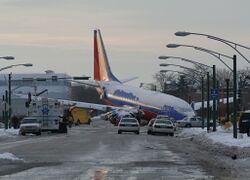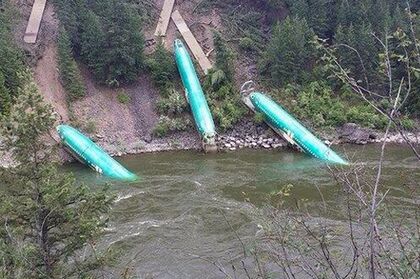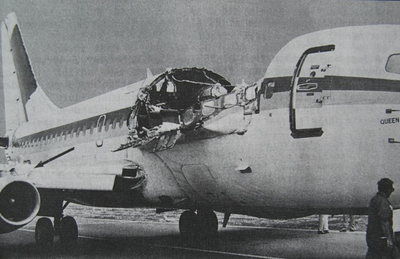Boeing 737
The Boeing 737 series is a series of medium-range airliners constructed by the Boeing Aircraft Company. While it was originally referred to as a 'narrow-body' airliner, the terms 'narrow-body' and 'wide-body' are now considered politically incorrect due to complaints lodged by upset 747s and a380s.
The 737 series has been manufactured by Boeing from the beginning of time. It comprises the 737 Jurassic series, the 737 Classic series, and the 737 Next Generation series. Currently, Boeing is most actively pursuing the production of the 737MAX, to secure orders from several airline CEOs who happen to be named 'Max'. Airbus has pursued the counter-strategy of naming its newest aircraft the A320 NEO, to appeal to fans of The Matrix.
The 737 series is the best selling family of aircraft in the history of aviation, with aviation experts agreeing that "over 9,000" 737s have been constructed already. Boeing says they owe their success to their aggressive marketing tactics, which include bribery, assassinations, and sabotage. The 737 is currently being produced at the primary Boeing factory, near some really rainy place.
737 Jurassic[edit]
The 737 Jurassic series was the original series of the 737. It consisted of the 737-100, the 737-200, and the 737-200Adv (which, as the name may suggest, is a more advanced version of the 737-200). The Jurassic series got its name after the makers of Jurassic Park payed Boeing the hefty sum of 800 trillion Zimbabwean dollars (around $.05 USD) to help advertize their movie. A similar offer to name the 737-100 the 'John Hammond' was turned down by Boeing. Boeing began developing the Jurassic series when they realized they were too poor to construct larger planes but still needed more revenue. As a result of this, the Jurassic series typically seated only 85 passengers (although with Ryanair's innovative seating configurations, the plane could carry as many as 7,943 people). The Jurassic series was equipped with Pratt & Whitney's 8==D engines, which gave the 737 advanced new features such as low fuel efficiency and pitifully short range. While the 737-100 was unsuccessful, the 737-200 was quite popular because Boeing cleverly hired Chuck Norris to force airlines into buying the plane or face immediate destruction.
737 Classic[edit]

Next came the 737 Classic series, which consisted of the 737-300, the 737-400, and the 737-500. The 737-300 was quite successful thanks to Boeing's intelligent and innovative marketing techniques. Boeing changed the engine shape and made the aircraft 6 inches longer (by duct-taping a stick to the nose) without changing anything else, luring many airlines into purchasing the plane while minimizing costs at Boeing. In addition, Boeing plastered bright red all-caps testimonials from "satisfied customers" on their home page (www.hotsinglesnearyou.kp) to help convince airlines. Furthermore, few airlines realized that they had been scammed playfully tricked by Boeing and kept using the 737-300 for decades.
However, some airlines became upset with the inadequate size of the 737-300, saying that it was 'too small' in front of all it's friends. This made the 737-300 extremely embarrassed and sad, so Boeing engineers traveled to the wilds of southeastern Mexico and spent what converted to $11 on a 'fuselage enlargement surgery' in a sketchy shack filled with Canadian refugees. The resulting aircraft, the 737-400, was much longer and larger than its puny predecessor and was much better equipped to satisfy the desires of many airlines.
The 737-500 was designed to be a more fuel efficient version of the 737-300. It made previous 737s feel bad about themselves and lead to high rates of aircraft suicide among 737-300s and 737-200s, causing at least 29 airlines to file for bankruptcy as they spent millions of dollars on antidepressants.
737 Next Generation[edit]
The Next Generation was, surprisingly, the next generation of the 737 and consisted of the 737-600, the 737-700, the 737-800, and the 737-900. The Next Generation 737s are significantly more fuel efficient than previous models because a group of Saudi Arabian OPEC officials wielding cock rockets broke into Boeing's headquarters and forced them to use less fuel, or face 'the consequences'.
The 737-800 is the most popular aircraft of this series, entirely because the number 8 is lucky in China, where nearly 93% of the world's population lives. While some so-called 'experts' claim that the 737-800's success owes to the fact that it's more efficient than much of the competition, all these idiots are wrong and need to shut up. The 737-900ER is also notable due to the fact that it can fly farther and carry more passengers than the other 737s. This is due to Boeing's innovative use of Southeast Asian child labor to run on treadmills and power the engines for hours on end.
Competitors[edit]
Throughout its long history, the Boeing 737 has received tough competition from many different aircraft.
- The Douglas DC-9 (officially known as the 'Death Craft 9') competed fiercely with the Boeing 737 for many years. Ultimately, Boeing got so pissed off with McDonnell Douglas that they bought the entire company.
- The Scarebus a320 series has also been a major competitor of the 737. Many airlines purchased the a320 after a stunning performance at a French air show. The a320, operated by Air France, performed a spectacularly fiery crash in front of all the spectators, many of whom were so impressed they immediately purchased a320s. Ever since then, the a320 has been almost as popular as the 737.
- The Embraer E-Jets are some of the 737's more recent competitors. Assembled by Amazonian women at a secret factory on a backwater of the Rio Puto, the E-jet family remains a popular choice among many airlines thanks to Rio de Janeiro based executives bribing airline officials with copious quantities of cocaine diluted with powdered sugar.
- Produced by the largest Chinese aircraft manufacturer, Boing, the Boing 7Tree7 is also a newer competitor. While Boing's 7Tree7 cannot be distinguished from Boeing's 737, it's actually manufactured entirely with a combination of 23-year-old plastic and highly toxic lead. Coincidentally, the 7Tree7 is also marketed as premium dog food under the name "Doggy Yum Yum Treat."
Safety[edit]
The 737 series has some fascinating safety features installed, as 4,293 people have found out. The most prominent of these is the 'scenic barrel-roll', a feature that automatically deflects the rudder of the plane all the way to the left or right. This causes the plane to do a roll for the enjoyment of the passengers, and as an added bonus, it quickly brings the plane to the ground to avoid boring holding patterns above busy airports. This feature is particularly exciting because it's programmed to occur randomly, building the suspense.
Some 737s have a 'C' attached to the end of their name (for example, the 737-700C). This C stands for 'Convertible', and means that the roof of the plane can peel off at a moment's notice, allowing the passengers AND crew to have a beautiful view of the sky and to feel the gentle 300 knot breeze in their hair.
If the pilots are skilled enough, some 737s can execute a special maneuver known as the 'picturesque river tour'. This maneuver is used to explore rivers and show passengers the scenery of the area. A notable example is Air Florida Flight 90: the skilled pilots decided that the ice-clogged Potomac River was too beautiful to be missed. After taking off from Reagan National Airport, they playfully bounced their aircraft off a bridge before entering the river, much to the delight of the passengers, who were eager to go swimming.


